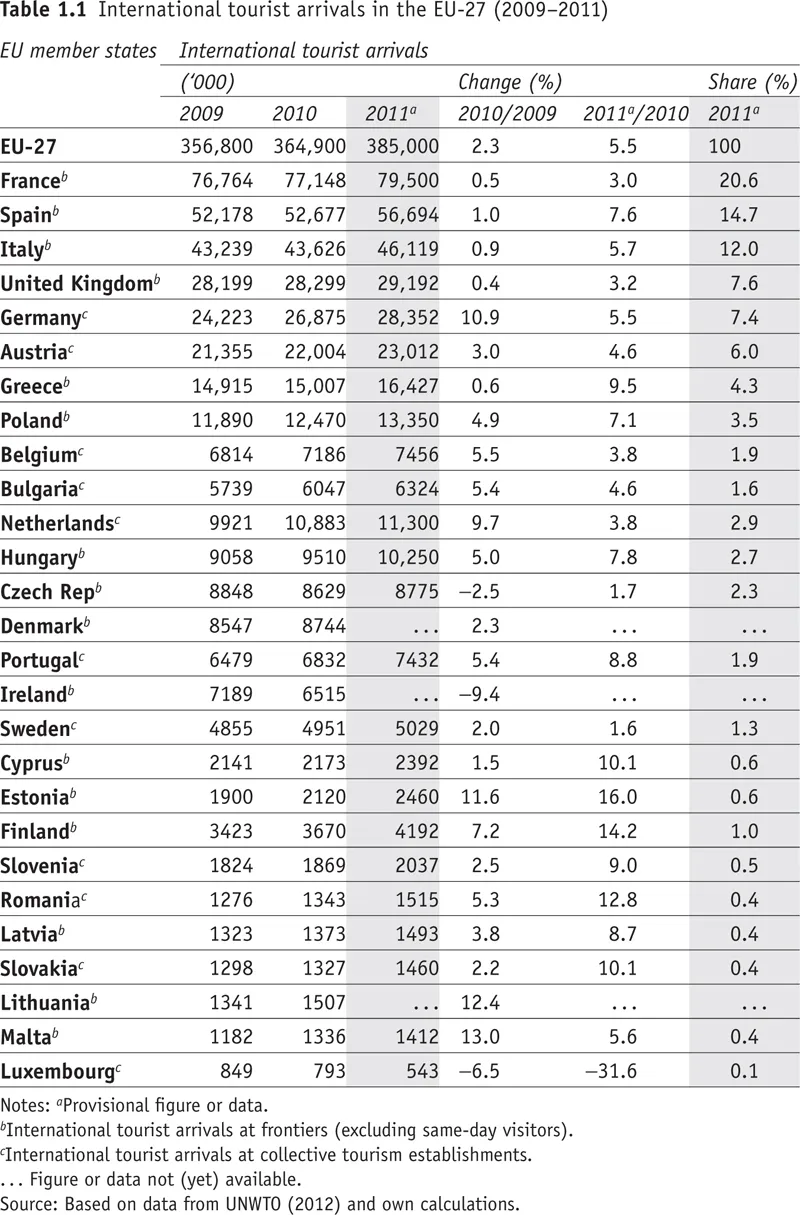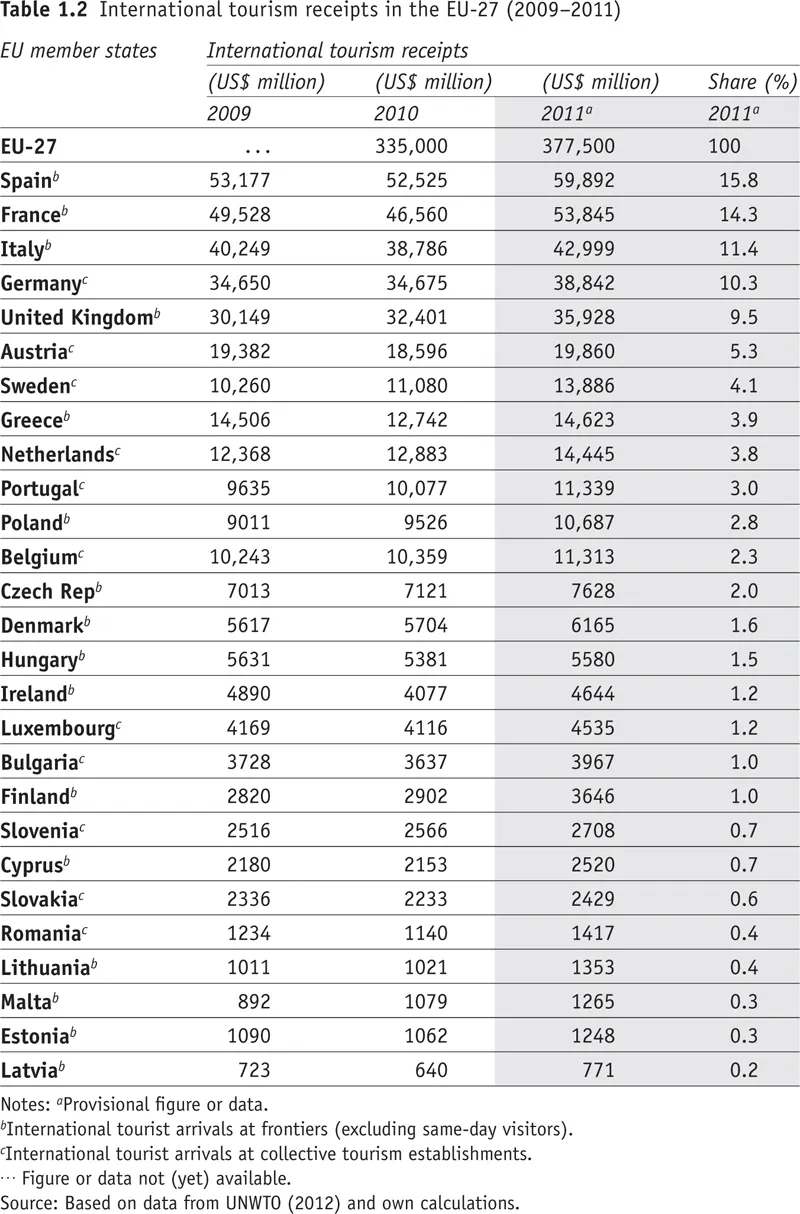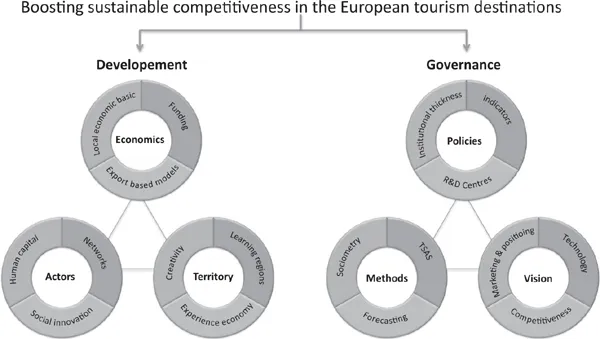![]()
1 A Comparative Approach to European Tourism Planning and Organisation Systems: An Introduction
Carlos Costa, Emese Panyik and Dimitrios Buhalis
Tourism and Economic Recovery in the European Union
Europe is facing an unprecedented crisis. The challenge of bringing together different economies and creating an enlarged economic market capable of boosting social and economic growth and competing with the giant American and Asian economies has pushed Europe into crisis. The need to create a single currency in order to help sustain a single economic market has driven Europe into crisis. Nowadays, the 27 European Union (EU) economies have to work together, supported by the same common financial policy. This ‘advantage’ has taken the EU economies to a level of competition and fiscal harmonisation that they were not prepared for.
However, despite the hardships of these challenging times, tourism is one of the few sectors of the world economy that continues to expand. Following a decline of 4% in 2009 suffered under the impacts of the global economic recession, international tourist arrivals grew by 6.4% in 2010 and 4.6% in 2011, reaching 983 million arrivals (UNWTO, 2012). Tourism has again confirmed its remarkable capacity for recovery, witnessed on previous occasions such as after the 9/11 attacks in 2001 and the 2003 SARS outbreak. Regional differences, however, have shown that the impacts of political crisis may be more detrimental to tourism than those of the economic crisis. In 2010, the fastest regions to recover were the Middle East (14%) and Asia and the Pacific (13%), while Europe’s recovery (+3%) was slower than in other regions (UNWTO, 2011). A year later, the opposite trend could be observed. In 2011, Europe was the fastest growing region in the world (+6.2%), with Asia and the Pacific slightly behind (6.1%), and the Middle East suffering a significant decline (-8%) together with North Africa (-9%) due to escalating political conflicts. Notably, the UNWTO identifies European growth both in relative terms (as compared to other regions) and in absolute terms (in number of visitors) as a key trend in 2011.
Certainly, Europe grew above expectations, particularly in light of the fact that the EU is still struggling with the sovereign debt crisis and the subsequent uncertainties in the Eurozone. Yet, while the UNWTO includes Turkey, Russia, the post-Soviet states and the Balkans in Europe, it is the EU that accounts for the overall majority of growth in international tourist arrivals and share of international tourism receipts registered in Europe (UNWTO, 2012). Perhaps the main conclusion one can draw from the impacts of the global financial crisis on European tourism is that EU residents do not give up on prioritising holiday travel even in times of economic recession. Specifically, while the length of stay of tourism trips has shortened and the number of business trips has dropped significantly since 2008, the number of holiday trips has remained roughly the same (EUROSTAT, 2012). Also, the accommodation sector has shown a clear recovery by 2011. The number of nights spent in hotels and similar establishments by tourists in the EU was well above the previous peak registered in 2007.
Furthermore, various countries with significant tourism potential wait at the EU’s door for admission. The largest expansion in its history was experienced in 2004 by the accession of 10 Central and Eastern European countries together with Malta and Cyprus. As part of the same wave of enlargement, Bulgaria and Romania joined in 2007, at which time the EU reached its current number of 27 member states. Yet Croatia’s accession on 1 July 2013 may be just the overture of a potential new wave of EU expansion in the Western Balkans. Albania and most successor states of the Socialist Federal Republic of Yugoslavia, including Macedonia, Montenegro and Serbia, have adopted EU integration as a strategic aim of their foreign policy and have recently been granted official candidate status (European Commission, 2010).
Furthermore, although the accession agreement with Turkey has frequently been called into question, the country has persistently sought membership for three decades. Together with Iceland, which suffered an economic collapse in 2008, both countries have preserved their official candidate status. The current debt crisis, however, has shown the limitations of a currency union without a common fiscal policy, and has driven the EU to the crossroads of structural change. In order to be able to effectively coordinate an increased number of diverse member states, it has become evident that the EU must first settle some fundamental structural issues of European legitimacy (Heinrich Böll Foundation, 2011).
While the financial crisis has impacted most significantly on Ireland and the EU’s southern periphery (the so-called PIIGS1), it is these countries that constitute some of the main tourism destinations in Europe. In fact, at least five out of the top 10 international destinations have traditionally been, and still are, EU members (France, Spain, Italy, the UK and Germany). It is also important to mention that Turkey, one of the main aspirants, was sixth in the ranking by international tourist arrivals in 2011 (UNWTO, 2012). These five member states are also among the top 10 tourism earners and, except for Spain, the top 10 biggest tourism spenders in the world.
International tourist arrivals and international tourism receipts between 2009 and 2011, broken down into the 27 member states, are presented in Tables 1.1 and 1.2. The top five European countries lead the ranking of countries in the EU-27 under both measures, but these data further indicate that the highest growth in international tourist arrivals (<10%) in relative terms was experienced in those countries with the lowest number of international arrivals (Cyprus, Estonia, Finland, Romania and Slovakia). In absolute terms, Spain is by far the leader of international tourist arrivals in the rankings, gaining 4 million more tourists in 2011 compared to 2010.
Comparative Tourism Policy Analysis of EU Member States
Various methodological approaches have been applied for the analysis of tourism policy in EU member states. As can be seen from Table 1.3, the analytical frameworks investigated the impacts of major politico-economic changes on tourism (Beech & Chadwick, 2006; Bramham et al., 1993a; Hall et al., 2006; Pompl & Lavery, 1993), employed analytical tools of a broader and more influential school of thought, namely regulation theory (Bramham et al., 1993b; Montanari & Williams, 1995), or used a thematic approach (Akehurst et al., 1994; Davidson, 1992; Thomas & Augustyn, 2007).
Davidson (1992), being one of the earliest contributors to comparative European tourism policy analysis, identified the compelling case for the treatment of Europe as a coherent unit of analysis in matters of tourism, and provided a comprehensive view of the major tourism trends in the then 12-member European Community (EC). The macro-regional focus was used by Williams and Shaw (1998) to systematically analyse the economic impacts of tourism in selected European countries and regions with special attention paid to Western Europe. Bramham et al. (1993a) provided an analysis of six countries of the EC, complemented by Sweden, Poland and the former Soviet Union. The policy changes resulting from the shift towards market-based economies in the East, and from social democratic welfare-based policies to entrepreneurial approaches in the West was at the centre of attention. Pompl and Lavery (1993) investigated the opportunities and threats arising from the introduction of the single European market in a predominantly demand-side analysis of EC members and Eastern Europe. Indeed, Lickorish (1991) argued for the establishment of a single European tourism policy and more centralised action by emphasising the opportunities arising from the single market and the increasing competition among continents.
Montanari and Williams (1995) adopted regulation theory for the analysis of European tourism from the perspective of global restructuring. Their central argument was that the spatial reorganisation of tourism production and consumption are linked to broader processes of economic, social and cultural change. On this theoretical basis, European tourism was segmented by regional population systems (Alpine, Mediterranean, British Isles, Scandinavia) and spatial reorganisation (coastal, rural and metropolitan areas).
Regulation theory was also applied by Bramham et al. (1993b), to identify the stages of leisure policy development through the case of selected European countries. The three thematic policy analyses used different analytic approaches. Thomas and Augustyn (2007) focused on one of the key features of European tourism supply, namely, that it is a largely SME2-dominated sector across the countries. They offered a comparative perspective on SME policies and business practices in old and new member states, candidates as well as non-members.
The principal guideline of Hall et al. (2006) was the enlargement implications of the unprecedented 2004 expansion of European tourism. This volume focused exclusively on the 10 new member states and the (then) four candidates. Akehurst et al.’s (1994) study was perhaps the only one that undertook a systematic analysis for the evaluation of policy instruments, activities and performance in all EC member states. This research found that successful tourism policies appear to be linked to central policy coordination regarding related areas (especially transport, environment, culture and regional development) and with governmental support for tourism development through the allocation of a tourism budget that concentrates on a few key areas.
In a recent publication, Costa et al. (2013) discuss the role played by tourism in Europe, and go further to show how new planning and organisational frameworks have to be designed, contributing to a more cohesive and integrated Europe. This new vision for Europe has to be built bearing in mind that the ‘Old Continent’ is made up of diverse and rich economies, which have to be managed with vision and creativity, and should respect centuries of cultural and historical growth. The future has to be built by considering the richness emerging from different realities which, when brought together, may represent one of the most important assets of a modern and competitive EU.
In this book a conceptual framework was proposed for the analysis of European tourism planning and organisation systems (see Figure 1.1), designed in recognition of new synergies between development and governance that have emerged at the beginning of the 21st century. The framework comprises six key elements (Actors, Territory, Economics, Policies, Methods and Vision), which were analysed through the emerging trends in the EU.
Figure 1.1 New linkages between development and governance: A procedural approach to European tourism planning and organisation
Source: Costa et al. (2013)
In the present book, this conceptual framework is applied and analysed systematically on the current 27 EU member states. The main objective is to explore 21st-century policy responses that have been given to the global challenges shaping tourism planning and organisation systems in the EU. To this end, each chapter is dedicated to one of the member states and begins with the characteristics and evolution of tourism in that country. Next, the actual tourism profile is reviewed in terms of supply and demand characteristics. The analysis then focuses on tourism policy, systematically presenting the national, regional and local levels of planning and organisation. The key issues and trends are identified and critically analysed with special attention to the EU relations. Each chapter closes with a discussion on future strategies and directions of development.
Costa et al. (2013) and the present volume therefore provide a coherent and sequential analysis linked by a theoretical framework. While the framework provides a new conceptualisation of planning and organisation, the systematic country-by-country application of the framework offers a new analytical approach to comparative policy analysis of EU member states.
Notes
(1) Acronym referring to the economies of Portugal, Ireland, Italy, Greece and Spain.
(2) Small and medium-sized enterprises.
References
Akehurst, G., Bland, N. and Nevin, M. (1994) Successful tourism policies in the European Union. Journal of Vacation Marketing 1 (1), 10–27.
Beech, J. and Chadwick, S. (eds) (2006) The Business of Tourism Management. Prentice Hall, NJ: Harlow.
Bramham, P., Henry, I., ...




